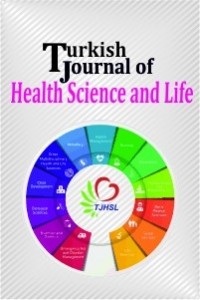Öz
Kaynakça
- 1. Roy N, Merrill RM, Thibeault S, Parsa RA, Gray SD, Smith EM. Prevalence of voice disorders in teachers and the general population. Journal of Speech, Language, and Hearing Research 2004 ;47(2):281-93.
- 2. De Jong FICRS, Kooijman PG, Thomas G, Huinck WJ, Graamans K, Schutte HK. Epidemiology of voice problems in Dutch teachers. Folia phoniatrica et logopaedica 2006;58(3):186-98.
- 3. Angelillo IF, Di Maio G, Costa G, Barillari U. Prevalence of occupational voice disorders in teachers. Journal of preventive medicine and hygiene 2009;50(1):26-32.
- 4. Benninger MS, Holy CE, Bryson PC, Milstein CF. Prevalence and occupation of patients presenting with dysphonia in the United States. Journal of Voice 2017;31(5):594-600.
- 5. Cohen SM, Kim J, Roy N, Asche C, Courey M. Prevalence and causes of dysphonia in a large treatment‐seeking population. The Laryngoscope 2012;122(2):343-8.
- 6. Kiakojoury K, Dehghan M, Hajizade F, Khafri S. Etiologies of dysphonia in patients referred to ENT clinics based on videolaryngoscopy Iran J Otorhinolaryngol 2014;26(76):169-74.
- 7. Martins RHG, do Amaral HA, Tavares ELM, Martins MG, Gonçalves TM, Dias NH. Voice disorders: etiology and diagnosis. Journal of voice 2016;30(6):761.e1-761.e9.
- 8. Roy N, Merrill RM, Gray SD, Smith EM. Voice disorders in the general population: prevalence, risk factors, and occupational impact. The Laryngoscope 2005;115(11):1988-95.
- 9. Nunes RB, Behlau M, Nunes MB, Paulino JG. Clinical diagnosis and histological analysis of vocal nodules and polyps. Brazilian journal of otorhinolaryngology 2013;79(4):434-40.
- 10. Preciado-López, J, Pérez-Fernández C, Calzada-Uriondo M, Preciado-Ruiz P. Epidemiological study of voice disorders among teaching professionals of La Rioja, Spain. Journal of voice 2008;22(4):489-508.
- 11. Silverman EM, Zimmer CH. Incidence of chronic hoarseness among school-age children. Journal of Speech and Hearing Disorders 1975;40(2):211-5.
Öz
Introduction: Children and adults can both be
affected by dysphonia, but patients of different ages have different
etiologies. Etiology can also change according to gender and season. We investigated patients who had dysphonia as the
primary symptom at our clinic and aimed to determine their etiologies,
differences between genders and
seasons, and related symptoms.
Materials and Method: This retrospective analysis was conducted at our
tertiary hospital between January 2019 and December 2019. Patients with dysphonia were
evaluated to determine the underlying diseases, differences between genders and
seasons, associated symptoms, and effect of smoking.
Results: In this study, 1160 patients with a mean age of 47.97
years were included; of these, 650 were male and 510 were female. The most
common cause of dysphonia was reflux laryngitis, affecting 208 patients
(17.9%). The most common season for dysphonia was autumn, accounting for 416
patients (35.9%). During autumn and winter, reflux laryngitis was predominant.
During spring and summer, vocal nodules were predominant. In addition, 98.3% of
patients with laryngeal malignancy had a history of smoking, and 97.93% of
patients with Reinke's edema were smokers.
Conclusion: Men are more prone to have dysphonia throughout their lifetime. Seasons have preponderance on the etiology of dysphonia in our country.
Reflux laryngitis is commonly seen during autumn and winter, and vocal nodules are frequent in
spring and summer.
Kaynakça
- 1. Roy N, Merrill RM, Thibeault S, Parsa RA, Gray SD, Smith EM. Prevalence of voice disorders in teachers and the general population. Journal of Speech, Language, and Hearing Research 2004 ;47(2):281-93.
- 2. De Jong FICRS, Kooijman PG, Thomas G, Huinck WJ, Graamans K, Schutte HK. Epidemiology of voice problems in Dutch teachers. Folia phoniatrica et logopaedica 2006;58(3):186-98.
- 3. Angelillo IF, Di Maio G, Costa G, Barillari U. Prevalence of occupational voice disorders in teachers. Journal of preventive medicine and hygiene 2009;50(1):26-32.
- 4. Benninger MS, Holy CE, Bryson PC, Milstein CF. Prevalence and occupation of patients presenting with dysphonia in the United States. Journal of Voice 2017;31(5):594-600.
- 5. Cohen SM, Kim J, Roy N, Asche C, Courey M. Prevalence and causes of dysphonia in a large treatment‐seeking population. The Laryngoscope 2012;122(2):343-8.
- 6. Kiakojoury K, Dehghan M, Hajizade F, Khafri S. Etiologies of dysphonia in patients referred to ENT clinics based on videolaryngoscopy Iran J Otorhinolaryngol 2014;26(76):169-74.
- 7. Martins RHG, do Amaral HA, Tavares ELM, Martins MG, Gonçalves TM, Dias NH. Voice disorders: etiology and diagnosis. Journal of voice 2016;30(6):761.e1-761.e9.
- 8. Roy N, Merrill RM, Gray SD, Smith EM. Voice disorders in the general population: prevalence, risk factors, and occupational impact. The Laryngoscope 2005;115(11):1988-95.
- 9. Nunes RB, Behlau M, Nunes MB, Paulino JG. Clinical diagnosis and histological analysis of vocal nodules and polyps. Brazilian journal of otorhinolaryngology 2013;79(4):434-40.
- 10. Preciado-López, J, Pérez-Fernández C, Calzada-Uriondo M, Preciado-Ruiz P. Epidemiological study of voice disorders among teaching professionals of La Rioja, Spain. Journal of voice 2008;22(4):489-508.
- 11. Silverman EM, Zimmer CH. Incidence of chronic hoarseness among school-age children. Journal of Speech and Hearing Disorders 1975;40(2):211-5.
Ayrıntılar
| Birincil Dil | İngilizce |
|---|---|
| Bölüm | Makaleler |
| Yazarlar | |
| Yayımlanma Tarihi | 25 Ekim 2020 |
| Yayımlandığı Sayı | Yıl 2020 Cilt: 3 Sayı: 2 |

